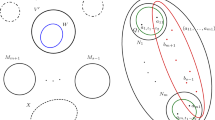Abstract
In classical coding theory, different types of extendability results of codes are known. A classical example is the result stating that every \((4, q^2-1, 3)\)-code over an alphabet of order q is extendable to a \((4, q^2, 3)\)-code. A constant dimension subspace code is a set of \((k-1)\)-spaces in the projective space \(\hbox {PG}(n-1,q)\), which pairwise intersect in subspaces of dimension upper bounded by a specific parameter. The theoretical upper bound on the sizes of these constant dimension subspace codes is given by the Johnson bound. This Johnson bound relies on the upper bound on the size of partial s-spreads, i.e., sets of pairwise disjoint s-spaces, in a projective space \(\hbox {PG}(N,q)\). When \(N+1 \equiv 0 \,\,(\text {mod }s+1)\), it is possible to partition \(\hbox {PG}(N,q)\) into s-spaces, also called s-spreads of \(\hbox {PG}(N,q)\). In the finite geometry research, extendability results on large partial s-spreads to s-spreads in \(\hbox {PG}(N,q)\) are known when \(N+1 \equiv 0\,\,(\text {mod }s+1)\). This motivates the study to determine similar extendability results on constant dimension subspace codes whose size is very close to the Johnson bound. By developing geometrical arguments, avoiding having to rely on extendability results on partial s-spreads, such extendability results for constant dimension subspace codes are presented.



Similar content being viewed by others
References
Ahlswede R., Cai N., Li S.Y.R., Yeung R.W.: Network information flow. IEEE Trans. Inf. Theory 46(4), 1204–1216 (2000).
Beutelspacher A.: On \(t\)-covers in finite projective spaces. J. Geom. 12, 10–16 (1979).
Blokhuis A.: On the size of a blocking set in \(\text{ PG }(2, p)\). Combinatorica 14, 111–114 (1994).
Blokhuis A., Storme L., Szőnyi T.: Lacunary polynomials, multiple blocking sets and Baer subplanes. J. Lond. Math. Soc. 60, 321–332 (1999).
Braun M., Etzion T., Ostergärd P.R.J., Vardy A., Wassermann A.: Existence of \(q\)-analogs of Steiner systems. (2013) (submitted).
Braun M., Kiermaier M., Nakić A.: On the automorphism group of a binary \(q\)-analog of the Fano plane. Eur. J. Comb. (2015) (to appear).
Bruen A.A.: Baer subplanes and blocking sets. Bull. Am. Math. Soc. 76, 342–344 (1970).
Dembowski P.: Finite Geometries. Springer, Berlin (1968).
Etzion T.: Problems on \(q\)-analogs in coding theory. ArXiv: arXiv:1305.6126v1 [cs.IT] (2013). (http://www.network-coding.eu/pubs.html).
Etzion T., Vardy A.: Error-correcting codes in projective space. IEEE Trans. Inf. Theory 57, 1165–1173 (2011).
Etzion T., Vardy A.: On \(q\)-analogs of Steiner systems and covering designs. Adv. Math. Commun. 5(2), 161–176 (2011).
Govaerts P., Storme L.: On a particular class of minihypers and its applications. I. The result for general \(q\). Des. Codes Cryptogr. 28, 51–63 (2003).
Hamada N.: Characterization of minihypers in a finite projective geometry and its applications to error-correcting codes. Bull. Osaka Women’s Univ. 24, 1–24 (1987).
Hamada N., Maekawa T.: A characterization of some \(q\)-ary linear codes \((q>(h-1)^{2}, h\ge 3)\) meeting the Griesmer bound. II. Math. Japon. 46, 241–252 (1997).
Hamada N., Tamari F.: On a geometrical method of construction of maximal \(t\)-linearly independent sets. J. Comb. Theory Ser. A 25, 14–28 (1978).
Heden O., Sissokho P.A.: On the existence of a (2, 3)-spread in V(7, 2). arXiv:1101.5336 (2011).
Hill R.: A First Course in Coding Theory. The Clarendon Press, New York (1986).
Honold T., Kiermaier M., Kurz S.: Optimal binary subspace codes of length 6, constant dimension 3 and minimum distance 4. Contemp. Math. 632, 157–176 (2015).
Ho T., Médard M., Kötter R., Karger D.R., Effros M., Shi J., Leong B.: A random linear network coding approach to multicast. IEEE Trans. Inf. Theory 52(10), 4413–4430 (2006).
Kiermaier M., Pavčević M.O.: Intersection numbers for subspace designs. J. Comb. Des. (2014) (to appear). doi:10.1002/jcd.21403.
Kötter R., Kschischang F.: Coding for errors and erasures in random network coding. IEEE Trans. Inf. Theory 54, 3579–3591 (2008).
Lambert L.: Random network coding and designs over \({\mathbb{F}}_{q}\). Master Thesis, Ghent University (2013) (http://www.network-coding.eu/pubs.html).
Metsch K.: Bose–Burton type theorems for finite projective, affine and polar spaces. Surveys in Combinatorics, 1999 (Canterbury), pp. 137–166. London Mathematical Society Lecture Note Series, vol. 267, Cambridge University Press, Cambridge (1999).
Miyakawa M., Munemasa A., Yoshiara S.: On a class of small 2-designs over \(GF(q)\). J. Comb. Des. 3, 61–77 (1995).
Thomas S.: Designs over finite fields. Geom. Dedicata 24, 237–242 (1987).
Thomas S.: Designs and partial geometries over finite fields. Geom. Dedicata 63, 247–253 (1996).
Yeung R.W., Li S.-Y.R., Cai N., Zhang Z.: Network Coding Theory. Boston, MA (2006).
Acknowledgments
The research of the first author was supported by a Short Term Scientific Mission (STSM) of the COST-project IC-1104 Random Network Coding and Designs over GF(q) (http://www.network-coding.eu/).
Author information
Authors and Affiliations
Corresponding author
Additional information
This is one of several papers published in Designs, Codes and Cryptography comprising the “Special Issue on Finite Geometries”.
Rights and permissions
About this article
Cite this article
Nakić, A., Storme, L. On the extendability of particular classes of constant dimension codes. Des. Codes Cryptogr. 79, 407–422 (2016). https://doi.org/10.1007/s10623-015-0115-1
Received:
Revised:
Accepted:
Published:
Issue Date:
DOI: https://doi.org/10.1007/s10623-015-0115-1



